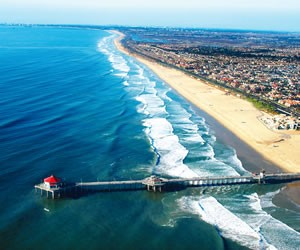The thaw is on at coastal resort hotels in the West. The meetings business that has been in the deep freeze for so long is gradually warming up.
"[Organizations] have finally figured out that not meeting was not working," says Nance Trevithick, director of group/incentive sales for The Resort at Pelican Hill in Newport Coast, Calif.
The downturn that coastal resorts (and many other high-end properties and hotels located in resort destinations, for that matter) have been dealing with for the past year continues. But there are signs that it is getting better.
"The coastal resort market is slowly beginning to recover," says hotel industry analyst Bruce Baltin, senior vice president for PKF Consulting in Los Angeles. "The data is just beginning to show movement, and there is anecdotal evidence as far as what we are hearing from general managers. Occupancy is going up and rates are going down. But we’ve been seeing lower rates everywhere."
For Huntington Beach, Calif., PKF figures show that occupancy was 62 percent in first quarter 2010 compared to 54 percent in first quarter 2009. In nearby Newport Beach, occupancy rose 11 percent over that same period. Rates fell 10 percent in the Huntington Beach market and 7 percent in Newport Beach.
Baltin says that it’s a good sign that occupancy is rising in Southern California, despite more room supply coming on-line in the past two years. And the bulk of that supply is in the form of coastal resorts. The Resort at Pelican Hill brought 334 units on-line (offering views of the Pacific with a coastal state park steps away), and Terranea Resort (located in Rancho Palos Verdes with Catalina Island nearby) brought 582 rooms to the market.
New Facilities
One of the signs of resiliency in the Western coastal resort market is that more properties are investing in facilities for groups. Coastal resorts in Mexico have had not only problems brought on by the recession and the AIG Effect, but also had to contend with the fallout from the H1N1 outbreak and the perception that Mexico is not safe for groups because of drug-related violence.
The Fairmont Acapulco Princess recently opened a new 20,000-square-foot exhibit hall that triples the amount of event space. The hall includes views of the ocean and can now host 6,000 people. In addition to the exhibit hall, there is a new area called Gourmet Rooms.
"This area has meeting rooms with new designs, contemporary furniture and colors that are fresh and modern. As the name indicates, Gourmet Rooms will offer also exquisite gastronomic options, specially designed for groups and conventions," says America Anguiano, director of public relations for Fairmont Princess Acapulco and Fairmont Pierre Marques, which is also located in Acapulco.
Booking Incentives
Coastal resorts are making themselves look a lot more attractive to planners because of the increasing number and variety of booking incentives. And many incentives are fashioned specifically for a particular group.
"Hotels are offering the group market a variety of incentives like credits on food and beverage, special spa services and packaging deals," Baltin says. "They are trying to maintain rates to some extent. But that’s been tough. Hotels were hit pretty hard in the last year."
Many coastal resorts are offering packages and streamlining charges as much as possible for planners.
"We are offering packages instead of nickel and diming. We are offering complimentary rooms when we can," says Tara Thomas, event sales manager for Kiwanda Hospitality Lodging and the Pelican Pub & Brewery in Pacific City, Ore. "It depends on what is important for the group. Because planners these days are not interested in paying for things the group doesn’t need. It’s about the bottom line."
Kiwanda Hospitality Lodging includes three properties in Pacific City: The Inn at Cape Kiwanda, The Cottages at Cape Kiwanda and Shoreline Vacation Rental Homes. The coastal town is an hour-and-a-half drive from Portland and just over an hour from Salem.
Jenn Houtby-Ferguson, director of sales and marketing for Tigh-Na-Mara Seaside Spa Resort in Parksville, British Columbia, says the resort is offering a variety of incentives for groups, including complimentary meeting space, two-for-one mineral pool passes, complimentary break service and early booking bonuses.
Some coastal properties, though, are not necessarily offering incentives in this buyers’ market.
"We have not seen the real need to offer incentives per se in order to have planners book," Pelican Hill’s Trevithick says. "What planners want is a sales professional to work with who has the empowerment to offer a great value to their organization that fits their personal needs, at a rate which will have inclusions rather than nickel and diming them once they book."
Associations Targeted
Coastal resorts in the West report that the AIG Effect is softening—a little.
"We are no longer seeing the same resistance to having a program at a luxury property like we had the past year and a half," Trevithick notes.
Some sectors of the meetings business are slower than others to consider meeting at a coastal resort. The perception issue is definitely a big reason why.
"Unfortunately for our government business this continues to be reality," Houtby-Ferguson says.
Several coastal resorts are witnessing more association and SMERF business since many resorts have lowered rates and are offering more value adds. Additionally, some of these resorts are seeking out association and SMERF business, since those groups weren’t hit as hard as the corporate side.
"We are seeing more association and SMERF business and interest from these groups," Thomas says. "Especially from regional associations that can drive in to meet, since our properties are close to Salem and Portland."
Trevithick adds: "We do have association business at Pelican Hill, however they tend to be smaller associations that can fit their membership at a smaller luxury property. In addition, we have had much success with association board retreats for larger organizations."
And some coastal resorts are assertively offering values exclusively for association business.
"We are really targeting more small-and mid-size associations and making our meeting room rates association-specific," Houtby-Ferguson says. "For example, we’re customizing the rates and offers which might include an association kickback or free meeting space for their board meetings."
Corporate Uptick
On the other side, corporate business is starting to pick back up, albeit very slowly.
"Face-to-face meetings once again are getting approved so colleagues can exchange best practices, energize their team and get business back on track," Trevithick says.
Houtby-Ferguson adds that she is seeing an uptick as well, but only slightly.
"Some of the sectors we used to see really often like lumber companies and pharmaceutical companies are still not back to their usual patterns," Houtby-Ferguson says.
Some coastal resorts are touting their value these days over bigger urban convention cities. These resorts aren’t always located on the main drag, so to speak, so the perception is that it’s going to cost more to hold a meeting.
"Costs in Pacific City are cheaper than Portland, for example," Thomas says. "Plus, the attendees would have the facilities to themselves so there’s no feeling that their group is getting lost in the hustle and bustle. So staying at a coastal property isn’t irresponsible at all, the planner can say to the company. Look at the dollars saved."
British Columbia’s Tigh-Na-Mara Resort is also positioning itself as a bargain when compared with urban centers, Houtby-Ferguson points out. The resort offers complimentary parking (a savings of $20 to $40 per vehicle per night), lower room rates than hotels in Vancouver or Victoria, and the Green Travel Assistance Fund.
The fund is available for groups using the Vancouver Island Conference Centre, as well as those groups travelling together. The resort pays for the ferry travel and coach transportation for groups coming from Vancouver.
"This is a greener way to go, and provides the opportunity for group discussion and team-building rather that individuals travelling separately," Houtby-Ferguson says.
The outlook for coastal resorts looks good, Baltin notes, but it’s going to take a while for the market to absorb room supply and stabilize, which could take a year to 18 months. In the meantime, he says that planners should take advantage of this time to get great deals with a great view.






